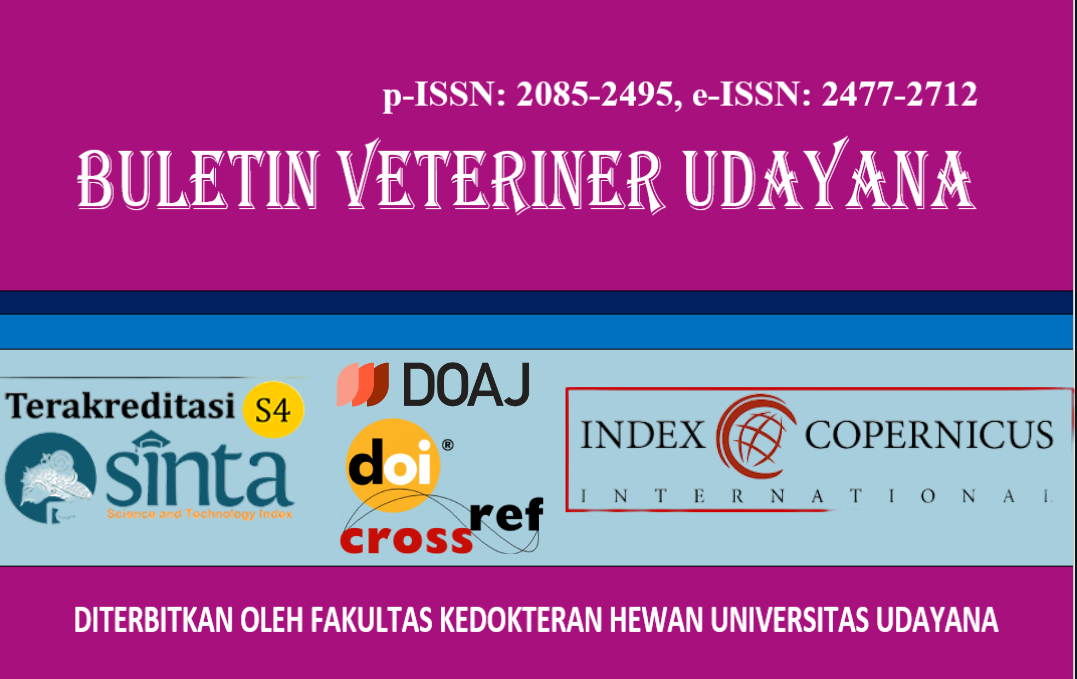MIGRATION LARVA TOXOCARA CANIS AND INFECTION WITH BABESIA SP. IN LOCAL DOGS
DOI:
https://doi.org/10.24843/bulvet.2024.v16.i05.p02Keywords:
dog, babesiosis, diarrhea, migrant larvae, toxocariosisAbstract
Toxocariosis is a disease caused by infection with the parasite Toxocara sp., which can disrupt gastrointestinal function. In chronic conditions, the parasite larvae are capable of migrating. The migration of Toxocara sp. larvae can affect various organs such as the liver and lungs, resulting in varied clinical symptoms. The purpose of this article is to report on the occurrence and management of cases in establishing diagnosis and providing therapy for dogs experiencing Toxocara canis larval migration. Methods included history taking, clinical examination, diagnostic tests, laboratory examinations for diagnosis confirmation, therapy administration, and evaluation of outcomes. A 3-month-old female dog weighing 2.5 kg, unvaccinated and not dewormed, presented with complaints of diarrhea, vomiting worms, occasional cough, and alopecia. Clinical examination revealed alopecia and erythema on the back and abdomen, tick infestation, enlarged abdomen, pale mucous membranes of the eyes and mouth, moist anus with fecal staining, and vomiting of worms. Hematological examination indicated macrocytic hypochromic anemia, monocytosis, lymphocytosis, and thrombocytopenia. Blood smear and antibody test kit were positive for Babesia sp. Abdominal and thoracic radiographs showed ascites and bronchopneumonia. Laboratory tests identified Toxocara canis using native examination, sediment examination, and eggs per gram count. Therapy involved administering pyrantel pamoate 25 mg/kg body weight orally, repeated after 2 weeks; furosemide 4 mg/kg body weight orally twice daily for 3 days; ivermectin 200 mcg/kg body weight intramuscularly, repeated after 2 weeks; doxycycline 10 mg/kg body weight orally once daily for 21 days; Hematodine 1 ml intramuscularly; Livron B-Komplek® orally once daily for 14 days; and fish oil orally once daily for 14 days. The dog was bathed twice a week with JF Sulfur soap. Evaluation after 3 weeks indicated clinical, hematological, and laboratory recovery, evidenced by normal hematological parameters, negative native stool examination, sediment examination, and eggs per gram count, negative blood smear examination, and normal mucosa, abdomen, respiration, and skin. In conclusion, treatment of Toxocara canis larval migration with pyrantel pamoate 25 mg/kg body weight orally effectively eliminated the parasite, while doxycycline 10 mg/kg body weight orally for 21 days successfully eliminated Babesia sp. Broad-spectrum deworming is recommended routinely to prevent and break the life cycle of gastrointestinal parasite infections.




